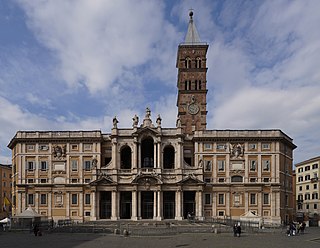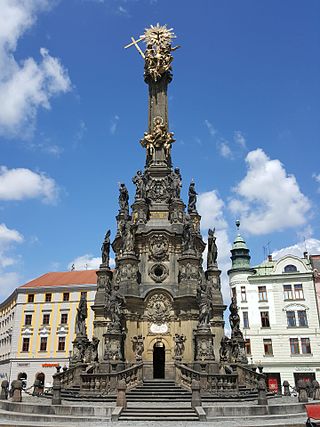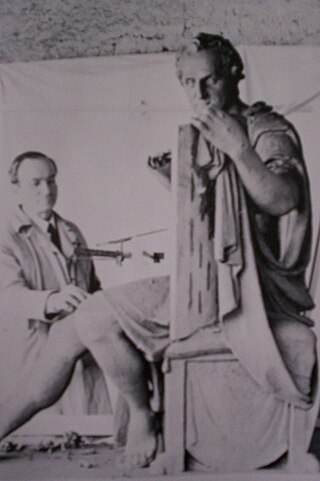
The Basilica of Saint Mary Major, or church of Santa Maria Maggiore, is a Major papal basilica as well as one of the Seven Pilgrim Churches of Rome and the largest Catholic Marian church in Rome, Italy.

Sant'Andrea della Valle is a minor basilica in the rione of Sant'Eustachio of the city of Rome, Italy. The basilica is the general seat for the religious order of the Theatines. It is located at Piazza Vidoni, at the intersection of Corso Vittorio Emanuele and Corso Rinascimento.

Marian columns are religious monuments depicting Virgin Mary on the top, often built in thanksgiving for the ending of a plague or for some other reason. The purpose of the Holy Trinity columns was usually simply to celebrate the church and the faith, though the plague motif could sometimes play its role in their erection as well. Erecting religious monuments in the form of a column surmounted by a figure or a Christian symbol was a gesture of public faith that flourished in the Catholic countries of Europe especially in the 17th and 18th centuries. Thus they became one of the most visible features of Baroque architecture. This usage also influenced some Eastern Orthodox Baroque architecture.

Pacentro is a comune of 1,279 inhabitants of the province of L'Aquila in Abruzzo, Italy. It is a well-preserved historic medieval village located in central Italy, several kilometers from the City of Sulmona about 170 kilometres (110 mi) east of Rome. It is a member of the I Borghi più belli d'Italia association.

The Spires of Naples are monumental columns in the historic center of the city of Naples, Italy.

Romano Vio was an Italian sculptor. He was born in Venice and taught sculpture there.

San Gaetano, also known as Santi Michele e Gaetano, is a Baroque church in Florence, Italy, located on the Piazza Antinori, entrusted to the Institute of Christ the King Sovereign Priest.

The Column of the Immaculate Conception is a nineteenth-century monument in central Rome depicting the Blessed Virgin Mary, located in what is called Piazza Mignanelli, towards the south east part of Piazza di Spagna. It was placed aptly in front of the offices of the Palazzo di Propaganda Fide which houses the Congregation for the Evangelization of Peoples.
Ignazio Jacometti was an Italian sculptor. He was a professor of sculpture at the Accademia di San Luca.

Grotta di Lourdes is an artificial cave in the Vatican gardens. It was built in 1902–05 and is a replica of the Lourdes Grotto in France. The context of building this grotto is the vision of the Madonna that a young girl, Bernadette Soubirous, experienced 18 times. Prior to that the Pope had promulgated the dogma of the Immaculate Conception in 1854.
The Chinèa was the name attached to a tribute paid by the Kings of Naples as vassals to the Popes. The tribute was apparently first recognized by the Norman King of Sicily in 1059. The Chinea reached its greatest magnitude from about 1550 to 1776, with grand temporary structures being erected during the celebration all over Rome in honor of the Pope. The Chinea ceremony itself was instituted under Charles I of Naples and Pope Clement IV, and lasted in ceremonial form till 1776, and as a monetary obligation until 1855.

San Francesco d'Assisi is a 16th-century-style church dedicated to Saint Francis of Assisi, located in Alcamo, province of Trapani, Sicily, southern Italy.

Nicosia Cathedral is the cathedral of the Roman Catholic Diocese of Nicosia, Sicily, and is located in Nicosia, Sicily, Italy. It is dedicated to Saint Nicholas of Bari. The Cathedral preserves a precious and unique wooden roof of 1300.

The Church of Saint Francis of Assisi is a Gothic-style, Roman Catholic church of Palermo. It is located near a major and ancient street of the city, via Cassaro, in the quarter of the Kalsa, within the historic centre of Palermo. The building represents the main Conventual Franciscan church of Sicily, and has the title of minor basilica.

Santa Caterina d'Alessandria or Saint Catherine of Alexandria is a Roman Catholic church with a main facade on Piazza Bellini, and a lateral Western facade facing the elaborate Fontana Pretoria, in the historic quarter of Kalsa in the city of Palermo, region of Sicily, Italy. In front of the main facade, across the piazza Bellini, rise the older churches of San Cataldo and Santa Maria dell'Ammiraglio, while across Piazza Pretoria is the Theatine church of San Giuseppe and the entrance to the Quattro Canti. Refurbished over the centuries, the church retains elements and decorations from the Renaissance, Baroque, and late-Baroque (Rococo) eras. This church is distinct from the Oratorio di Santa Caterina found in the Olivella neighborhood.

The Praetorian Fountain is a monumental fountain located in Piazza Pretoria in the historic center of Palermo, region of Sicily, Italy. The fountain dominates the piazza on the west flank of the church of Santa Caterina, and is one block south of the intersection of the Quattro Canti. The fountain was originally built in 1544 in Florence by Francesco Camilliani, but was sold, transferred, and reassembled in Palermo in 1574.

The Church of Saint Teresa is a Baroque Roman Catholic church, located on Piazza della Kalsa, facing the Porta de Greci in the ancient quarter of the Kalsa of the city of Palermo, region of Sicily, Italy.

Piazza San Domenico is a square of Palermo, Sicily, southern Italy. It is located down Via Roma, in the quarter of La Loggia, within the historic centre of Palermo. The square derives its name from the Church of San Domenico, one of the famous city sights. In the past it was called "Piazza Imperiale", because its creation was decided by the Emperor Charles VI.

The Fountain of the Genius of Fieravecchia is a historic fountain located in Piazza Rivoluzione in the ancient quarter of Kalsa in the historic center of Palermo, region of Sicily, Italy.
The Monument to Giovanni Meli is a bronze monumental sculpture, dedicated to the Sicilian poet, erected in 1909 on Piazza Stazione Lolli, near Via Dante, in central Palermo, Sicily.



















